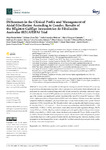Mostrar o rexistro simple do ítem
Differences in the Clinical Profile and Management of Atrial Fibrillation According to Gender. Results of the REgistro GallEgo Intercéntrico de Fibrilación Auricular (REGUEIFA) Trial
| dc.contributor.author | Durán-Bobín, Olga | |
| dc.contributor.author | Elices-Teja, Juliana | |
| dc.contributor.author | González-Melchor, Laila | |
| dc.contributor.author | Vázquez-Caamaño, María | |
| dc.contributor.author | Fernández-Obanza, Emiliano | |
| dc.contributor.author | González-Babarro, Eva | |
| dc.contributor.author | Cabanas-Grandío, Pilar | |
| dc.contributor.author | Piñeiro-Portela, Miriam | |
| dc.contributor.author | Prada-Delgado, Oscar | |
| dc.contributor.author | Gutiérrez-Feijoo, Mario | |
| dc.contributor.author | Freire, Evaristo | |
| dc.contributor.author | Díaz-Castro, Oscar | |
| dc.contributor.author | Muñiz, Javier | |
| dc.contributor.author | García-Seara, Javier | |
| dc.contributor.author | González-Juanatey, Carlos | |
| dc.date.accessioned | 2021-09-28T08:01:42Z | |
| dc.date.available | 2021-09-28T08:01:42Z | |
| dc.date.issued | 2021-08-27 | |
| dc.identifier.citation | Durán-Bobín O, Elices-Teja J, González-Melchor L, Vázquez-Caamaño M, Fernández-Obanza E, González-Babarro E, Cabanas-Grandío P, Piñeiro-Portela M, Prada-Delgado O, Gutiérrez-Feijoo M, Freire E, Díaz-Castro O, Muñiz J, García-Seara J, Gonzalez-Juanatey C. Differences in the Clinical Profile and Management of Atrial Fibrillation According to Gender. Results of the REgistro GallEgo Intercéntrico de Fibrilación Auricular (REGUEIFA) Trial. J Clin Med. 2021 Aug 27;10(17):3846. | es_ES |
| dc.identifier.issn | 2077-0383 | |
| dc.identifier.uri | http://hdl.handle.net/2183/28522 | |
| dc.description.abstract | [Abstract] To analyze the clinical profile and therapeutic strategy in atrial fibrillation (AF) according to gender in a contemporaneous patient cohort a prospective, multicenter observational study was performed on consecutive patients diagnosed with AF and assessed by cardiology units in the region of Galicia (Spain). A total of 1007 patients were included, of which 32.3% were women. The mean age of the women was significantly greater than that of the men (71.6 versus 65.7 years; p < 0.001), with a higher prevalence of hypertension (HTN) and valve disease. Women more often reported symptoms related to arrhythmia (28.2% in EHRA class I versus 36.4% in men), with a poorer level of symptoms (EHRA classes IIb and III). Thromboembolic risk was significantly higher among women (CHA2DS2-VASc 3 ± 1.3 versus 2 ± 1.5), in the same way as bleeding risk (HAS-BLED 0.83 ± 0.78 versus 0.64 ± 0.78) (p < 0.001), and women more often received anticoagulation therapy (94.1% versus 87.6%; p = 0.001). Rhythm control strategies proved significantly less frequent in women (55.8% versus 66.6%; p = 0.001), with a lesser electrical cardioversion (ECV) rate (18.4% versus 27.3%; p = 0.002). Perceived health status was poorer in women. Women were older and presented greater comorbidity than men, with a greater thromboembolic and bleeding risk. Likewise, rhythm control strategies were less frequent than in men, despite the fact that women had poorer perceived quality of life and were more symptomatic. | es_ES |
| dc.language.iso | eng | es_ES |
| dc.publisher | MDPI | es_ES |
| dc.relation.uri | https://doi.org/10.3390/jcm10173846 | es_ES |
| dc.rights | Creative Commons Attribution 4.0 International Licence (CC-BY 4.0) | es_ES |
| dc.rights.uri | https://creativecommons.org/licenses/by/4.0/ | * |
| dc.subject | Anticoagulation | es_ES |
| dc.subject | Atrial fibrillation | es_ES |
| dc.subject | Gender | es_ES |
| dc.subject | Rhythm control | es_ES |
| dc.title | Differences in the Clinical Profile and Management of Atrial Fibrillation According to Gender. Results of the REgistro GallEgo Intercéntrico de Fibrilación Auricular (REGUEIFA) Trial | es_ES |
| dc.type | info:eu-repo/semantics/article | es_ES |
| dc.rights.access | info:eu-repo/semantics/openAccess | es_ES |
| UDC.journalTitle | Journal of Clinical Medicine | es_ES |
| UDC.volume | 10 | es_ES |
| UDC.issue | 17 | es_ES |
| UDC.startPage | 3846 | es_ES |
| dc.identifier.doi | 10.3390/jcm10173846 |






